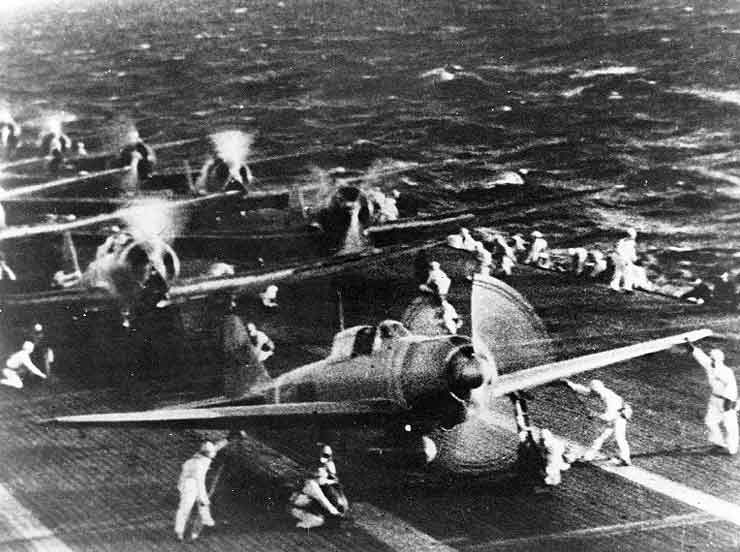
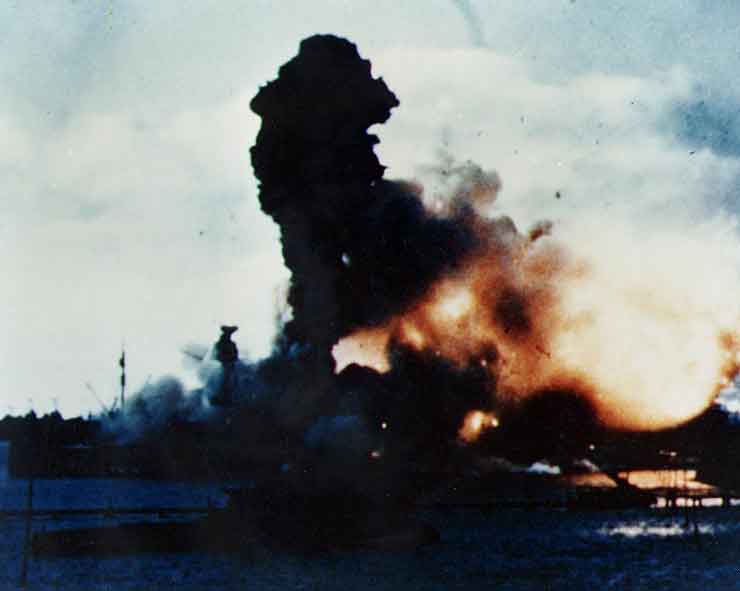
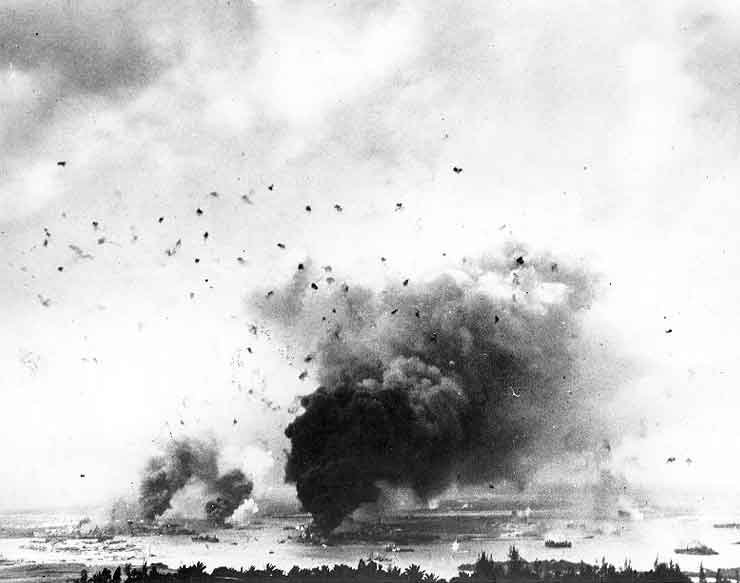
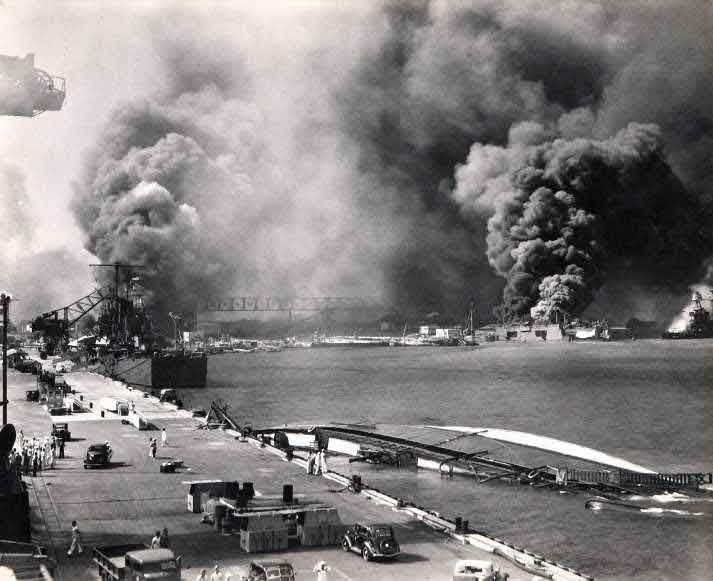
The blue grave... Pearl Harbor
The surprise attack of Japanese army on Pearl Harbor on December 7, 1941 buried many young men into the blue grave of the Pacific ocean.




In June 1940 US president Franklin D. Roosevelt transferred a large part of the United States fleet to Pearl Harbor on Hawaii as a presumed deterrent to a possible Japanese aggression. As Japan was now deeply in war with China which raged since 1937, the large, and ever growing, heavily equipped, disciplined and well trained Japanese Army was running out of resources and was in bad need of them. In July 1941 the western powers including the United States of America effectively halted trade with Japan. Desperate Japan, was falling in a deep economical crises because of that, and their goal were the oil, and mineral riches of East Indies, and Southeast Asia. It looked as though the war in Pacific was inevitable. Both Japan, and USA as the dominating nations on the Pacific were preparing for a war, although a diplomatic solution was tried to be found. Pearl Harbor was clearly being prepared as a major naval base, but there was much to be done. By May 1940 when most of the US fleet from the west coast was transferred to Pearl Harbor, work on the base had already begun. Its Navy Yard had a dry dock capable of holding the largest warships, a marine railway for smaller ones, and an industrial plant for repairing and maintaining these ships. In the center of Pearl Harbor was located an island called Ford island, commonly referred to as "Battleship Row". It was called like that because Ford island had a row of mooring and docking locations along its east coast, as well as a berthing area. The war ships would then line up in a row, and that's how its name originated. The island its self also served as an air base, for the US Army combat airplanes, as well as for patrol planes. To the Southeast of the navy yard was a submarine base, and located nearby were large oil tanks. All this was well, but the base had a big flaw that its only exit to the sea, and as it would prove the only escape later on was a narrow channel. From a security point of view this was very dangerous. As work on the bas progressed, peace talks started failing. By late November 1941 peace talks were clearly nearing to an end, and it was at that time that the U.S. intelligence found out that they could expect an attack into the Indies, Malaya and probably the Philippines. They did not expect an attack from the east, and not on Pearl Harbor. Some other factors influenced the level of readiness on the island that day. The base although having all these facilities, was not large enough to support such a large amount of soldiers, and army personnel, machinery... soldiers housing, and recreational facilities, were largely inadequate, and they didn't really feel welcome from the local population, who didn't really like the idea of such a large number of soldiers coming to their island in such a short time. The Pearl Harbor naval base was recognized by both the Japanese and the United States Navies as a potential target for hostile carrier air power. The U.S. Navy had even explored the issue during some of its interwar "Fleet Problems". However, its distance from Japan and shallow harbor, the certainty that Japan's navy would have many other pressing needs for its aircraft carriers in the event of war, and a belief that intelligence would provide warning persuaded senior U.S. officers that the prospect of an attack on Pearl Harbor could be safely discounted. During the interwar period, the Japanese had reached similar conclusions. However, their pressing need for secure flanks during the planned offensive into Southeast Asia and the East Indies spurred the dynamic commander of the Japanese Combined Fleet, Admiral Isoroku Yamamoto to revisit the issue. His staff found that the assault was feasible, given the greater capabilities of newer aircraft types, modifications to aerial torpedoes, a high level of communications security and a reasonable level of good luck. Japan's feelings of desperation helped Yamamoto persuade the Naval high command and Government to undertake the venture should war become inevitable, as appeared increasingly likely during October and November 1941.
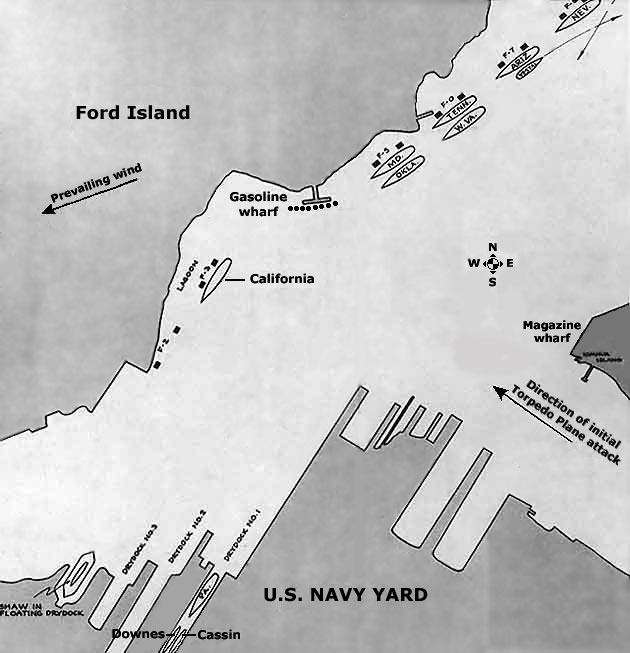
Japan had 6 first-line aircraft carriers, Akagi,
Kaga,
Soryu,
Hiryu,
Shokaku
and Zuikaku with over 420 planes under the command of Vice Admiral
Chuichi Nagumo, and experienced, and causious officer were assigned to the
mission of attacking Pearl Harbor, and constituted the largest and most
powerful carrier task force ever assembled. His
Pearl Harbor Striking Force also included fast battleships, cruisers and
destroyers, with tankers to fuel the ships during their passage across the
Pacific. An Advance Expeditionary Force of large submarines, five of them
carrying midget
submarines, was sent to scout around Hawaii, dispatch the midgets into Pearl
Harbor to attack ships there, and torpedo American warships that might escape to
sea. Pearl Harbor was reachable by an aircraft carrier
force, and the Japanese Navy secretly sent one across the Pacific with greater
aerial striking power than had ever been seen on the World's oceans. Soon after, Japanese planes eliminated much of the American
air force in the Philippines, and a Japanese Army was ashore in Malaya. Under the greatest secrecy, Nagumo took his ships to sea on
November 26, 1941,
with orders to abort the mission if he was discovered, or should diplomacy work
an unanticipated miracle. Before dawn on the 7th of December, undiscovered and
with diplomatic prospects firmly at an end, the Japanese navy was less than three-hundred miles north of Pearl Harbor. A first attack wave of over
180 aircraft, including torpedo planes, high-level bombers, dive bombers and
fighters, was launched in the darkness and flew off to the south followed soon
by a second attack wave of similar size, but with more dive
bombers and no torpedo planes. Near Oahu's southern shore, the
five midget submarines had already cast loose from larger subs they were
attached to and were trying to make their way into Pearl Harbor's narrow entrance channel. When
the first Japanese attack wave arrived over Pearl Harbor seven of their primary
targets, the U.S. battleships, were moored along "Battleship Row", on
the eastern side of Ford Island. Another battleship was in dry-dock in the nearby
Navy Yard. Other moorings which the Japanese believed might include battleships,
or the equally important aircraft carriers, were at the navy yard's 1010 dock
and along Ford Island's western side. Japanese planes
hit Pearl Harbor at 7:55 AM on December 7 1941. Within a short time five of eight battleships
at Pearl Harbor were sunk or sinking, with the rest heavily damaged. Several other ships
and most Hawaii-based combat planes were also knocked out and over 2400 soldiers
died. The Japanese first targeted airfields,
including that on Ford Island. Dive bombers attacked there at about 7:55 AM,
destroying many aircraft, among them PBY patrol planes at the island's southern
tip. This attack prompted the dispatch of the famous message "Air raid,
Pearl Harbor -- this is no drill", the outside world's first indication
that war had come to the Pacific. Within a few moments, torpedo planes attacked
from east and west, with one of the latter torpedoing the USS Helena at
1010 dock. Others, from the same direction, hit USS Utah and USS Raleigh,
off the western side of Ford Island. The great majority of the torpedo planes
came in from the east, flying up the waterway between Pearl Harbor Navy Yard and
the Submarine Base to hit the ships on that side of Ford Island. They put two
"fish" into USS California, at the southern end of the row. At
the northern end, another struck USS Nevada. The outboard ships in the
center of "Battleship Row", USS Oklahoma and West Virginia,
each had their port sides torn open by many torpedoes. As the torpedo planes
were completing their work, horizontal bombers dropped armor-piercing bombs "Battleship
Row". Most spectacular of the bombers' victims was Arizona,
which was struck many times. One bomb penetrated to the vicinity of her forward
magazines, which detonated with a massive blast, immediately sinking the ship.
Planes of
the second attack wave revisited some of the ships already hit, and also spread
destruction in the Navy Yard, where they bombed the dry-docked battleship Pennsylvania
and three destroyers. Other dive bombers went after the Nevada, which had
left her berth and was trying to get to sea. Very heavy anti-aircraft gunfire
greeted these aircraft, whose losses were significantly greater than those of
the first attack wave. The raiders had no opportunity to hit American aircraft
carriers, all of which were at sea.
Twenty-four of the forty Japanese torpedo planes were assigned to attack
"Battleship Row", and five more diverted to that side of Ford Island
when they found no battleships in their intended target areas. Twenty-nine Type 91 aerial torpedoes
each with a warhead of some 450 pounds of
high explosive, of which twenty-one found their targets: two hit California,
one exploded against Nevada and as many as nine each struck Oklahoma
and West Virginia. The latter two ships sank within minutes of receiving
this torpedo damage. Horizontal
bombers, armed with heavy armor-piercing bombs, arrived just as the last torpedo
planes finished their attacks, and other horizontal and dive bombers came in
later. Together, these planes scored many hits or damaging near-misses on the
"Battleship Row" ships: two on California, Maryland and Tennessee;
a few on West Virginia. Nevada,
which got underway during the latter part of the attack, attracted many dive
bombers, was hit repeatedly as she steamed slowly between Ford Island and the
Navy Yard, and, sinking and ablaze, had to be run ashore. In
addition to strategically vital "Battleship Row", the Japanese thought
two other areas were important enough to warrant attention from the initial
Pearl Harbor attack wave's torpedo planes. These were the long 1010 Dock at the
Navy Yard, and the fixed moorings on the western side of Ford Island, both of
which might hold battleships or aircraft carriers. On the morning of 7 December
1941, the latter location was occupied by the seaplane tender Tangier,
the old target and training ship Utah and the light cruisers Raleigh
and Detroit. Six aerial torpedoes were launched against these ships, of
which three hit, sinking one vessel and nearly sinking another. The
thirty-year-old Utah, which had been converted from an obsolete
battleship ten years earlier, received two torpedoes, completely overwhelming
her very limited ability to absorb underwater damage. She capsized to port in
about ten minutes, coming to rest with her bottom in the air. As Utah's
crew were abandoning ship and swimming through the oily water to Ford Island,
they were the target of machine-gun attacks by Japanese planes. Although ten
trapped Sailors were later cut free from her upturned hull, about sixty were
lost with their ship. USS Raleigh
was hit by one torpedo and a bomb. Of an old and not very sturdy design, she
barely avoided capsizing, but her crew, assisted by a salvage barge and a tug,
kept her upright and afloat. Also damaged west of Ford Island was the
seaplane tender Curtiss,
hit by a crashing enemy dive bomber, plus one bomb and fragments of another
during the second wave attack. Curtiss was also unsuccessfully attacked
by a Japanese midget submarine, which fired a torpedo at the seaplane tender and
was then promptly sunk by the destroyer Monaghan. The initial Japanese
attack wave hit the Pearl Harbor Navy Yard area relatively lightly, with a few
torpedoes launched at ships along 1010 Dock and some dive bombers targeting that
vicinity and the dry-dock area immediately to the southward. The torpedo planes
made one hit, on the light cruiser Helena, opening two of her engineering
spaces to the sea. The minelayer Oglala,
tied up alongside Helena, fared much worse. This old converted passenger
ship had her port side opened up by the blast of the torpedo that hit the
cruiser, and the resulting inrush of water could not be controlled. About two
hours later, Oglala rolled over to port and sank alongside 1010 Dock. The second Japanese attack wave's horizontal and dive bombers gave the
Navy Yard's dry-dock area considerable attention. Though their efforts were
somewhat mitigated by the diversion of some planes against USS Nevada as
she passed nearby, these bombers made several hits, wrecking three destroyers
and damaging the battleship Pennsylvania. The latter, Flagship of the
Pacific Fleet and one of the raiders' priority targets, was "high and
dry" in Dry-dock number one with destroyers Cassin
and Downes.
One bomb hit Pennsylvania amidships, killing eighteen crewmembers and
producing modest damage to the battleship. Other bombs, hitting on and near the
two destroyers, opened their fuel tanks and set intense fires. Ammunition
explosions, including the detonation of a torpedo on Downes, added to the
destruction, which was compounded when the dry-dock was partially flooded. Cassin
then lifted off her blocks and rolled over against Downes. Dive
bombers from the second wave also struck the destroyer Shaw, which was in
the floating dry-dock YFD-2. The resulting fires spread to Shaw's
forward magazines, which blew up spectacularly, severing her bow. However, the
rest of the ship remained afloat as the dry-dock sank beneath her. The little tug
Sotoyomo, also in YFD-2, was badly burned by Shaw's fires
and went down, too. Japanese
bombs near-missed some of the ships at the piers in the northeastern part of the
Navy Yard, producing notable damage to the hull of light cruiser Honolulu.
However, the attackers' concentration on battleship targets left the Yard's
vital industrial facilities essentially untouched. These were soon hard at work
on rescue, repair and salvage jobs, of which there were many immediately at
hand. Military and Naval aircraft at Oahu's airfields were second only to
battleships among the Japanese target priorities, though the reason was
different. Wheeler Army Airfield, in central Oahu, was
Hawaii's main fighter base. While Pearl Harbor's battleships represented American strategic
"reach", and had to be eliminated, Oahu's aircraft had to be attacked
because they could protect the Pearl Harbor attack force, and the Japanese
feared that is the U.S. army brought up the airplanes into the air they could
even loose the battle so the Japanese first
attack wave therefore assigned many fighters and bombers to attack the airbase. The second attack wave also had
airfield strikes among its tasks. It was heavily attacked. Of some 140 planes on the
ground there, mainly P-40 and P-36 pursuits, nearly two-thirds were destroyed or
put out of action. A similar proportion of the B-17, B-18 and A-20 bombers at
Hickam Army Airfield, adjacent to the Pearl Harbor Navy Yard, was also wrecked
or damaged enough to keep them grounded. Many men were killed at Hickam when the
Japanese bombed their barracks. Smaller Bellows Field in eastern Oahu was also
hit, destroying several P-40s, including two whose pilots courageously attempted
to take off in the teeth of the enemy onslaught. U.S. Navy and Marine Corps air
stations on Pearl Harbor's Ford Island, at Ewa to the west of Pearl and at
Kanoehe Bay near Bellows Field, were also attacked. Ewa's aircraft complement, mainly carrier-type bombers and fighters,
was reduced from nearly fifty operational planes to less than twenty. Ford
Island and Kanoehe, home to several squadrons of long-range PBY patrol
seaplanes, were massively attacked, with Ford Island losing about half its
planes and Kaneohe all but a few. These very successful Japanese strikes thus
prevented any significant aerial opposition, though the few Army fighters that
got airborne gave a good account of themselves. Later on December seventh,
surviving bombers and patrol planes were sent out to search for the Japanese
carriers. They found nothing and confronted considerable "friendly"
anti-aircraft gunfire when they returned to their bases.
The 7 December 1941 Japanese raid on Pearl Harbor was one of the great defining moments in history. A single carefully-planned and well-executed stroke removed the United States Navy's battleship force as a possible threat to the Japanese Empire's southward expansion. America, unprepared and now considerably weakened, was abruptly brought into the Second World War as a full combatant.
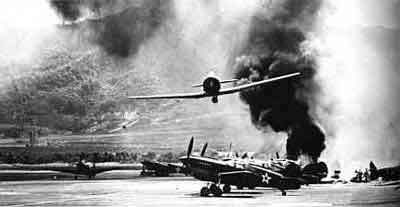
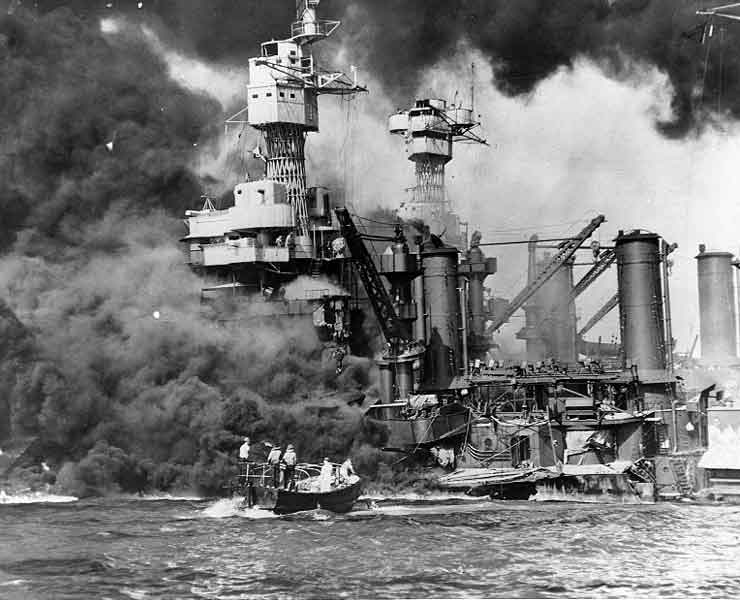
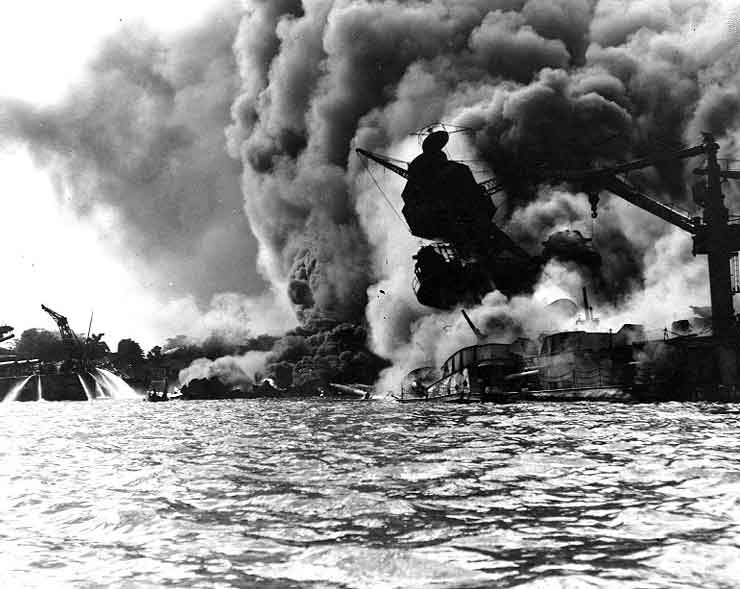
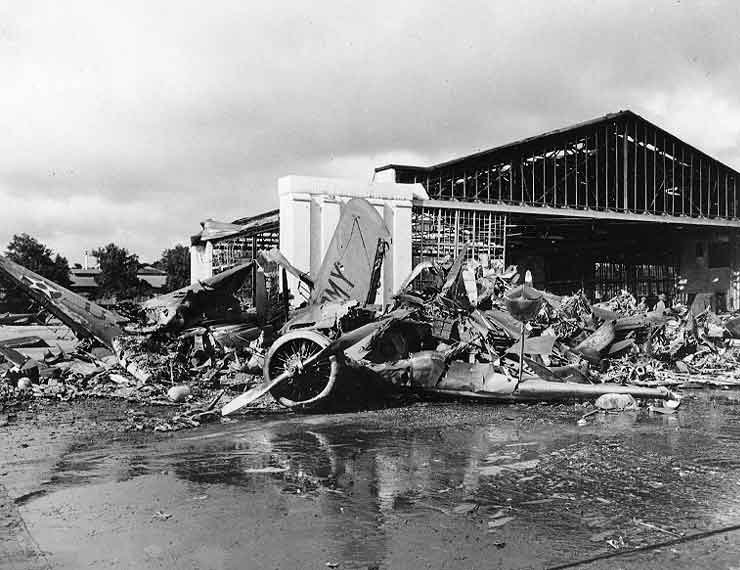
Pearl Harbor will forever be remembered for the brave American soldiers who unfortunately lost their lives in a fight against Japanese Imperial expansion, and will be remembered as the start of the war for so many brave men that will give their lives not only in defense of their fatherland, but for the future of the world and all of us who live today.
Web site made by Igor Radisic from Belgrade, Serbia & Montenegro. E-mail: [email protected]
60 years later... D-day | Bloody city... Stalingrad | A bridge too far... Operation Marketgarden | Dust in the wind... El Alamein | Horrific thunder... Kursk
© Copyright protected. All rights reserved. Igor Radisic 2004 - 2005